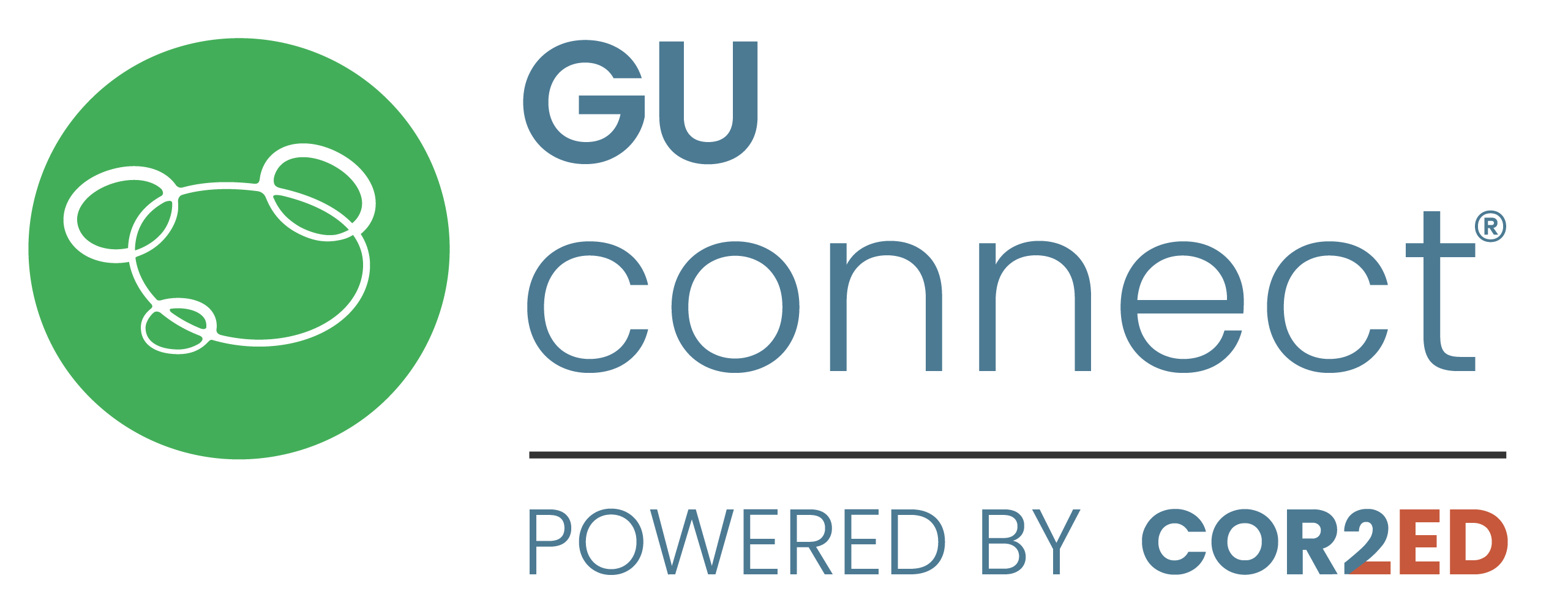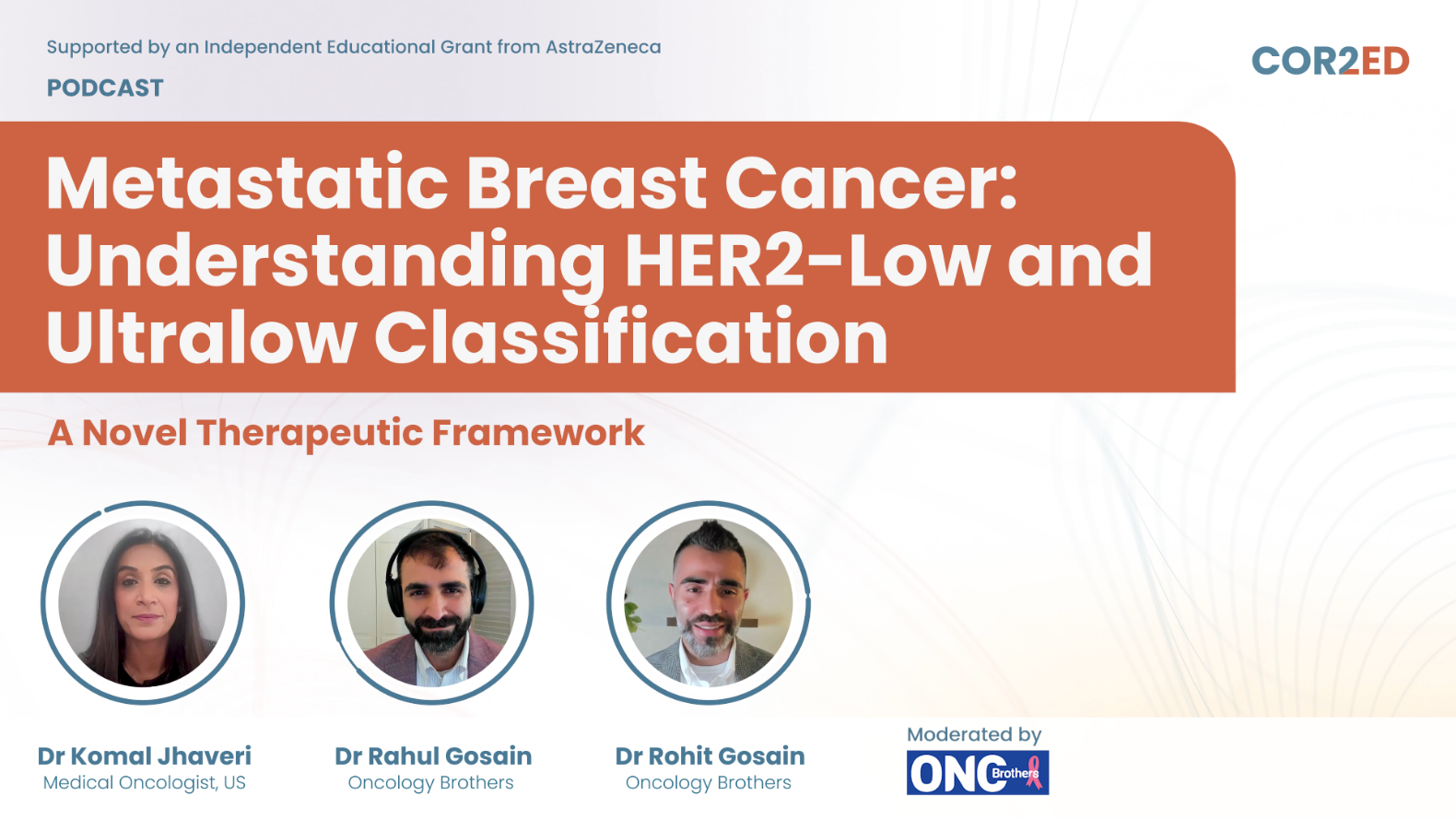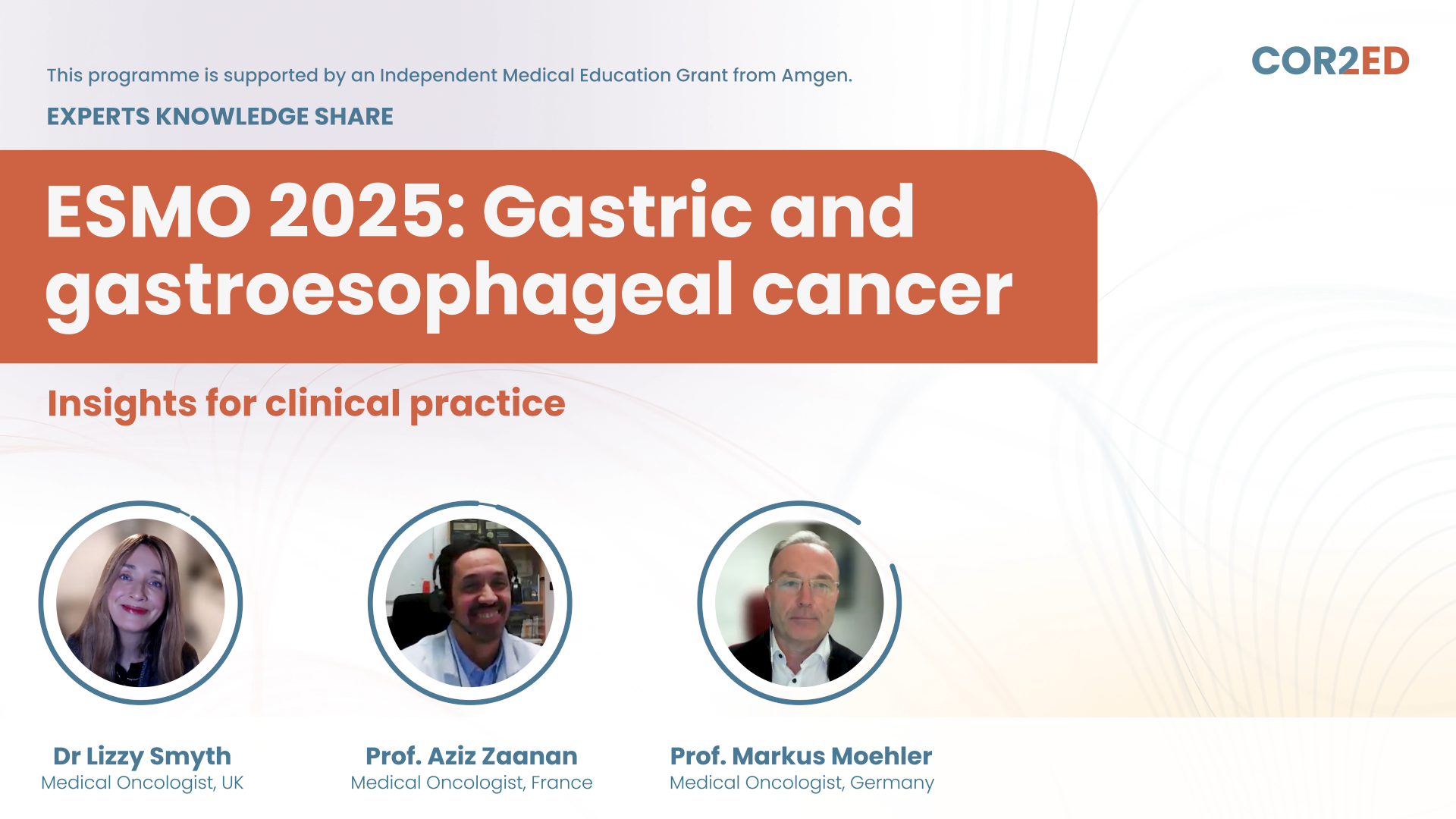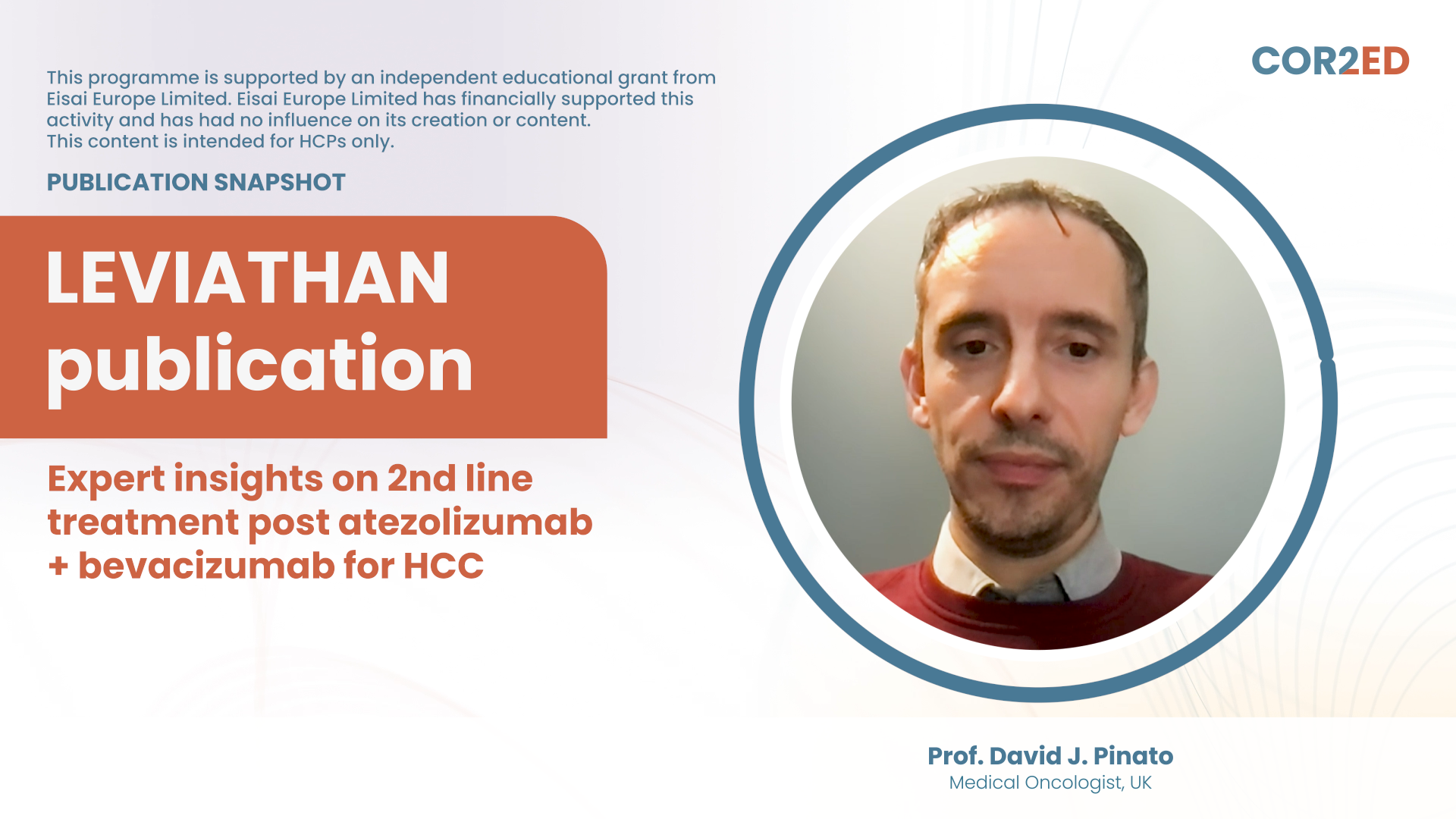Prostate Cancer Highlights from ASCO GU 2022
Please note:
GU CONNECT podcasts are designed to be heard. If you are able, we encourage you to listen to the audio, which includes emotion and emphasis that is not so easily understood from the words on the page. Transcripts are edited for readability. Please check the corresponding audio before quoting in print.
This GU CONNECT programme is supported through an independent educational grant from Bayer is an initiative of COR2ED.
The views expressed within this podcast are the personal opinions of the authors. They do not necessarily represent the views of the author’s academic institution, or the rest of the GU CONNECT group.
Transcript
Alicia: Hello and welcome to this podcast covering prostate cancer highlights from ASCO GU 2022. My name is Alicia Morgans and I'm a GU medical oncologist at Dana-Farber Cancer Institute in Boston in the US, and I'm excited to be joined today by Dr. Neal Shore. Neal, perhaps you could introduce yourself.
Neal: Yeah, thanks very much, Alicia. It's always great to be with you and review data. I am a Uro-Oncologist, the CMO, chief medical officer for GenesisCare and Urology and Surgical Oncology. It was really wonderful to see you in person and many of our colleagues in San Francisco, and I'm looking forward to reviewing some of the important plenary presentations. So thanks, it's always great to be with you.
Alicia: It's always great to be with you, too, Neal. And as you said, just wonderful to see everyone in person after such a long time. So, you and I have selected a number of key abstracts that we wanted to discuss today just to discuss our different perspectives as a urologist and a medical oncologist. Perhaps we could start with the first abstract that we've chosen, and this is the ARASENS trial. Neal, can you tell us a little bit about the study and what your thoughts are?
Neal: Yeah, I'd be really happy to. I know you and I were both investigators in this, and this is a very important trial. This was started over four years ago, came on the heels of the really important data that we saw from CHAARTED and STAMPEDE that ADT and plus docetaxel, six cycles, in the mCSPC population clearly had an advantage for high-risk, high-volume patients. And then concomitantly, right after that, we saw the LATITUDE and additional STAMPEDE data that ADT plus abiraterone was particularly survival prolonging for low- and high-volume patients.
So ARASENS, the first phase three trial, addressed the issue of triplet therapy, which I think some or most of our colleagues would understand, and that is your patients who present with metastatic castration sensitive prostate cancer, and it can be in various tumour burdens and various histopathologies and PSAs. Essentially it was about 1300 patients, global study, randomised 1:1, about 650 patients in each arm and in the control arm patients received ADT plus six cycles of docetaxel and an oral placebo.
In the treatment arm, which ARASENS was addressing, was ADT plus six cycles of docetaxel and concomitant darolutamide (erratum: 600mg BID). During the time of the trial development, there was work going on looking at darolutamide in the nmCRPC space known as the ARAMIS trial. So, this goes back to the concept of intensification of treatment. Is it well tolerated? More importantly, does it have efficacy? And Matthew Smith presented from the podium at ASCO GU and demonstrated that the primary endpoint of overall survival was clearly met. The hazard ratio was just slightly better than 0.70. The results were statistically significant, including many key secondary endpoints. The tolerability, which I was very pleased to see, was for an approximate five year follow up was very consistent with the tolerability that we've seen in both ARAMIS long term data and also real-world reports. So, this really is truly game-changing. That's what Matthew Smith said in his presentation. And to the credit of the investigators, there was a simultaneous online publication in the New England Journal.
Alicia: Absolutely. You know, I think from a medical oncologist perspective, this study was the first to really give us an all-comers population that seemed to benefit from the triplet approach. And when I say all-comers, I should clarify to say that, of course, all of the patients in this trial were eligible and fit for chemotherapy. So that is a distinction from the real-world population that we see in clinic with metastatic hormone-sensitive disease, because some of those patients certainly are not going to be fit for chemotherapy, as you know. But the patients who are fit for chemotherapy, as you mentioned, seem to benefit so substantially, and the side effect profile seemed relatively low burden.
And so, from my perspective, it seems like a relatively easy decision to add that darolutamide upfront when we're starting chemotherapy and then just continue it and really an interesting approach for our patients, and I'm happy to have something to do after finishing chemo because although it's nice to have six cycles and then be done and just continue on with your backbone of androgen deprivation therapy, I think that the thought of taking some additional pills and getting such a benefit is not one that would be lost on patients, they would really, I think, find that appealing.
And I wonder from your perspective, as a urologist who is unique as a urologist of course, gives systemic therapies, but really has his finger on the pulse of the urology community in general, which may not give as many systemic therapies. How do you think this data is actually going to affect your clinical practice as a urologist and generally clinical practice in this space for these patients?
Neal: Yeah, I appreciate that. You know, I think the North Star should always be how do we optimise patient care and do it in a safe manner. We see so many patients in North America who end up succumbing to mCRPC. And, you know, market analysis suggests that they get on average close to, but not even really two life-prolonging therapies. I like the idea of providing therapeutic intensification for the right patient as we often say, the right patient who's fit for chemo clearly. Obviously, the investigators who enrol these patients felt that they were. The mCSPC population tends to be younger compared to mCRPC groups, and therefore their performance status is usually better. A lot of our colleagues in the discussion were saying, well, they broke it down by M1a, M1b and M1c, which is kind of an older convention as opposed to the verbiage is now more low volume, high volume, or high risk. I think it's fair to say and I remember, Dr. Smith was asked this, but the vast majority of these patients and we didn't see that breakdown analysis, were clearly high volume, high risk. So, and as you say, Alicia chemo eligible. As it relates to urology in your question, you know, in different parts of the world, our Japanese colleagues, our German colleagues are very, very comfortable, that is urologists, in giving systemic therapies, less so in North America. But to me, it's always been as long as the patient is getting quality care, and frankly, the multidisciplinary team is really the best standard. This data really, I think, requires us to look beyond not just ADT and adding doce(taxel) and daro(lutamide), but we still have many patients and throughout the world who have mCSPC and they just get monotherapy ADT. You and I have worked together with ASCO back in 2020, demonstrating that even with all the couplet treatments, ADT doce(taxel), ADT abi(raterone), ADT apa(lutamide), ADT enza(lutamide) so many urologists just use monotherapy, watch the PSA go down and declare victory. But now we have just an abundance of level one evidence that to optimise patient care, level one evidence a survival prolongation, we have to do better.
Alicia: I would agree and I think that in terms of clinical practice, if we can at least move the bar to using combination therapy and really considering that in the metastatic hormone-sensitive setting, the backbone has to be ADT plus an AR-targeted agent at this point, and then we can add docetaxel from my perspective based on the data, if we find that that's right for the patient. That would be, I think, the way that I try to think about this. But you know, of course, that's not exactly how ARASENS was designed, but to your point of the bigger issue that we have in prostate cancer, it's time for us to really think about this intensified androgen deprivation as being standard of care and the first thing that we do in the metastatic hormone-sensitive setting.
Neal: Yeah, I fully agree with you. And you know, one note is that the control arm, the ADT/ doce(taxel)/placebo in ARASENS had a disproportionate amount of life-prolonging therapies, as you'd probably expect, because those patients progressed sooner. And yet the overall survival clearly still benefited the triplet therapy. Yeah, I mean, life prolongation, intensification and not to compromise safety and tolerability. Of course, for many of our colleagues around the world, it's also about accessibility and cost, and we continue to move forward to try to make that less of an issue for anyone who presents with advanced prostate cancer.
You know, Alicia, we saw really fascinating concomitant presentations for patients who were to receive first-line mCRPC and these are the use of combination therapies. And the trials were similar, but there were some really key differences for our mCRPC patients, and I'm referring to the PROpel trial and the MAGNITUDE trial. The combination here being abiraterone acetate with prednisone plus olaparib that was PROpel, versus a control arm of abiraterone and in MAGNITUDE it was niraparib, a different PARP inhibitor with abiraterone. So, can you give us an overview?
Alicia: Absolutely. And I really commend our field for getting these studies done and for coming up with, I think, what is really quite a compelling biologic rationale that wouldn't necessarily be considered unless we really did some of that early work, that preclinical work and then and saw some interesting signals in phase 2.
So let's start with the PROpel trial, but of course, we're going to talk about both. These are both, as you said, similar studies that are occurring in the first line, metastatic CRPC population. Patients could have been exposed to docetaxel in the PROpel trial in the metastatic hormone-sensitive setting, but not in the mCRPC setting. And these patients who had not yet been exposed to an AR-targeted agent were enrolled and randomised in a 1:1 fashion to abiraterone with or without olaparib. Importantly, in the PROpel trial, this included all comers, so they didn't know in advance whether patients had DNA repair defect alterations, that wasn't required for their enrolment, that wasn't required for a prospective stratification or plan. It was really something that was assessed, of course, but was not part of the prospective management or construction of the trial. The primary endpoint was radiographic progression-free survival by the investigators assessments. But of course, they had secondary endpoints, some of which are not yet mature, like overall survival.
So, in terms of that radiographic PFS assessment, what they found was that the combination of abiraterone and olaparib was associated with an improvement of rPFS with a hazard ratio of 0.66, and this was highly statistically significant. That, of course, was by investigator assessment but was upheld by the blinded independent central review, which had a hazard ratio of 0.61. So really, even when the centrally reviewed images were compared, that was maintained, which I think is important. Also important on the subgroup analyses those patients who had HRR mutations and those patients who did not have HRR mutations both appeared to benefit from the combination of abiraterone and olaparib. So, it wasn't just those patients with these DNA repair defect mutations who seemed to benefit. And as I mentioned, the survival data is not yet mature, so we will have to wait to find out where things ultimately go.
In terms of the safety profile, there were not any new safety signals, and there had been some questions raised in prior studies about cardiac events and perhaps about thromboembolic events, and there wasn't a significant difference between the groups in terms of that, though these were, of course, events of interest and were assessed. So, in general, when I look at this data and this phase 3 trial, I think it's really interesting that this preclinical consideration that the combination of abiraterone and a PARP inhibitor, in this case olaparib, might lead to a BRCA-ness type of a profile that seemed to bear out even in patients who don't have those DNA repair defect alterations. So really interesting and I think really pretty compelling data.
Neal: Yeah, that's a really great overview. Yeah, you're absolutely right. So what we've learnt, what did earlier trials that led to the approval of olaparib, the first and, you know, major landmark paper, which was the PROfound trial led by Maha Hussain and Johann de Bono, was really an important study that showed that patients with homologous recombinant repair mutations did markedly better when they were sequenced after progressing on a novel hormonal agent to a PARP inhibitor versus getting sequenced to another novel hormonal agent, which we see a lot of that sequencing that occurs.
As you said, this study 8 that Noel Clarke presented on a few years back at ASCO prior to the pandemic, demonstrated in an all-comers population that the combination was effective. And you've done a great job in reviewing this. This rPFS data is really quite significant, especially in the setting for first-line mCRPC, where the control arm is an active agent abiraterone acetate, and many of our colleagues are saying “well, we want to see overall survival”. That's a typical comment, I should say regulatory approval pathway. Often times, many of our major phase 3 studies have had co-primary endpoints, but it really was quite dramatic. The combination, and as you say, why would that work? Why would it intuitively work in a wild type HRR population? Well, the combination enhances the BRCA-ness perhaps, and enhances PARP inhibitor activity.
And similarly, there's data to suggest that the AR-receptor is also potentially modified in such a way as to decrease resistant pathways. I think it was reassuring to see that only with a small number of patients who were found to have pulmonary embolic phenomenon, mostly on radiographic imaging, that it was pretty well tolerated, a little bit more in total side effects as you'd expect when you combine two agents versus one. And so, the other thing Alicia, I'd love to ask you this, does PROpel teach us that we shouldn't get next-generation sequencing testing?
Alicia: Well, that is a great question and so important for us in clinical practice because I think over the last few years, we've all recognised that this is something that if we do want to do it, we need to set up the systems, have our clinics set up so that we can identify the patients, have the workflows arranged so that we can effectively send out for these tests. And that hasn't always been an easy process. And so, of course, if there's information that suggests that we no longer need to do that, then it would be a load off of everyone's shoulders, I think. However, I don't think that that's what PROpel suggests, particularly when we're thinking about germline testing, because we do know that the rate of germline DNA defects or these HRR mutations, amongst other heritable family cancer syndrome mutations, the rate in this metastatic population is over 11%, at least in some of the data that we have to sort of look at this population. And in this study itself, it was even higher. So I think that when we're thinking about germline testing in particular and the implications that this testing can have for families, for daughters who need to continue to go through screening for breast cancer or to consider whether they have symptoms that may suggest they have ovarian cancer, or for sons who may be at risk for prostate cancer and for anyone who may be at higher risk because of these syndromes of pancreatic cancer or colon cancer or other heritable syndrome type cancers, we need to make sure that our patients have access to that information.
It's not all about the therapeutic implications, and I would also say that as we move further and further into this era of precision medicine, understanding the genetic makeup of the patient and understanding the genomic makeup of the tumour is not going to be something that we turn away from. This is increasingly important and may also give us opportunities to use other therapies in the future. So long answer, but short answer is no. It does not mean that, Dr. Shore.
Neal: I'm so happy you said that because I fully agree, and I don't think that's what the goal of PROpel was to say is not to do testing. Testing is extremely important for all the reasons that you said. Interestingly, it was about 30 per cent of the patients had HRR mutations, very similar to what we saw in the PROfound study. But you're absolutely right, cascade family testing. And I think we're going to see additional sub-analyses of the different HRR mutations and how those patients did versus those with wild type. So I think, you know, this is going to be very provocative for us to continue to think about a subset analysis and how patients ultimately do. And then like so many things that we talk about as you know, safety, tolerability and cost, and I'll be interested to see how that works out over time.
Alicia, you did an amazing job, as you always do in summarising studies, and so the PROpel was a little bit more straightforward, you know, two arms, all comers. The MAGNITUDE was a little bit more of an academic design study, meaning that it was two arms. But each arm then also had a bifurcation and had two arms. Can you kind of do the overview on how MAGNITUDE was that study design was different in sort of an overarching way? And what did that study teach us?
Alicia: Absolutely. And I would say that the MAGNITUDE design reminded me a little bit of the PROfound design just in that they had these different cohorts to try to really look so much more closely at patients by these different HRR mutation subgroups. And I also would commend the team that designed the trial because they built in a futility analysis that would prevent patients who were not going to benefit from the combination that I'll talk about, prevent them from getting ongoing treatment and being included in a trial if they were not actually going to benefit. So I really think that this design was a good one, especially from a patient perspective.
So just like PROpel, the MAGNITUDE trial was a trial that was designed to assess the first line of therapy in metastatic CRPC and prior taxane exposure with docetaxel was allowed if it was given in the metastatic hormone-sensitive setting. But patients were enrolled, they were all prospectively assessed for DNA repair defect alterations, and there were a number. Again, these were very similar to those included in some of the studies we've seen before, including PROfound. And they were allocated to a particular cohort either the HRR biomarker positive cohort or the HRR biomarker negative cohort. And the reason that I mentioned this important design is because within each cohort, these patients were randomised to treatment with abiraterone and ADT with or without niraparib. And of course, there was a similar idea that the combination of an AR-targeted agent and a PARP inhibitor here might result in a BRCA-ness that might help even those patients who are HRR mutation-negative. However, in the HRR mutation-negative cohort in this MAGNITUDE trial, there did not seem to be a benefit to the combination of abiraterone and niraparib as compared to abiraterone alone. And you mentioned before this abiraterone control arm here being actually quite a powerful control arm. This is a highly active therapy and is one of our most used agents. So this combination was certainly up against quite an uphill battle, I would say. But importantly, there was not a benefit and this arm, this cohort stopped enrolling. And I think that's important from a patient perspective, not enrolling in a combination that's not expected to help. The study, of course, continued enrolling in the HRR positive subset and the primary endpoint here was radiographic progression-free survival. And when the investigators looked at the radiographic progression-free survival endpoint after completing enrolment, they found a hazard ratio, demonstrating a benefit to the combination of abiraterone and niraparib versus abiraterone and ADT alone of 0.53, and this was highly statistically significant. So this was a centrally reviewed radiographic progression-free survival endpoint demonstrating that benefit, and it was very, very strong. Importantly, these patients also seem to benefit in terms of having that combination versus the abiraterone alone in terms of time to symptomatic progression, as well as PSA progression. This was all very consistent as they continued follow up and looked at these secondary endpoints. So from my perspective, this also demonstrated a benefit to that combination of an AR-targeted agent and the PARP inhibitor in this case, niraparib, and was a really interesting trial that demonstrated tolerable safety profile and compelling results.
Neal: That was fantastic. So here you have in MAGNITUDE, their final report, 100% of the patients who had an HRR mutation. I think about 40% were BRCA2, who clearly had an impressive hazard ratio and an rPFS benefit, OS is still waiting. One of my questions is, there were some important differences and you brought them up in terms of the inclusion criteria and why there was a futility analysis or a futility analysis that demonstrated futility and the control arm, as opposed to what we see in the 70% of patients in the PROpel study that didn't have a mutation and that clearly there seemed to be benefit in that overall population. One of the things I thought was important from Kim Chi’s presentation at ASCO GU was demonstrating that, you know, our patients who have BRCA2 and other HRR mutations, it's clearly a worsening phenotype and biology that correlates with the genomic profiling; these patients, it's just a more virulent form of the disease.
So I guess based upon the findings of MAGNITUDE and PROpel Alicia, how would you apply this today in your clinic when you see patients this week? I guess it's a little bit of a tough question, right? You're going to kind of want to wait till the final OS in both studies and have an opportunity to read the publications. But let's assume that there's an approval or there's some access to get combination therapy. How do you think about this now in the clinic?
Alicia: I think that's one of the most important questions for these trials, in particular because as we've discussed earlier, androgen receptor-targeted agents like abiraterone are things that we're trying to use in the metastatic hormone-sensitive setting or perhaps in the non-metastatic CRPC setting, not abiraterone, but other agents, because we're trying to use this ADT plus intensified approach as early as possible. You know, whether in your clinic or in my clinic, we're going to have a lot of patients in the first line mCRPC setting who have not been exposed to abiraterone previously. Whether there's going to be a large enough population to make a meaningful difference in our practices, I think remains in question.
However, if we look at real world data, we know that we are as a community not intensifying. So at least half of patients are not getting that intensified strategy early on. So I do think that this will affect a lot of patients. It will probably affect my patients after we see the survival data, after we have an approval for niraparib in this setting and an expansion of approval, perhaps for olaparib in this setting. But I do think that as we continue to evolve as a field, we may see this type of an approach get extrapolated even into the hormone-sensitive setting. And of course, that's a pretty big leap. And I think that the trials need to be done to show us that that's going to be of benefit. But I wonder if that may be what may happen in some patients, particularly younger patients, particularly patients I would think with HRR mutations who people want to potentially be as aggressive as possible and patients want to be as aggressive as possible. But just to be clear for the audience, I am not suggesting that we should do that and we don't have the data to show that that's actually the way to go. I just know that as physicians, sometimes we take some leeway in what we actually do in clinic, and I wonder if that may be the way that we go as we try to move treatments earlier on and help patients more effectively.
Neal: Yeah, a great point. Absolutely. Clearly, the PARP inhibitors are not approved in mCSPC, we have, you know, two approvals in mCRPC, the combination is not yet approved, but it certainly seems like there's a possibility that it could moving forward and then how to square this data for patients who have a mutation, typically most commonly on BRCA2.
Alicia: You know, these certainly were big blockbuster therapeutic trials, but we saw some really interesting and actually quite compelling data in other arenas. And one of the most interesting, I thought, was a presentation by Dr. Daniel Spratt on the use of artificial intelligence and how it may be used to predict whether androgen deprivation therapy may be of benefit to patients and when given with radiation in patients who have localised prostate cancer. Really trying to understand which patients are going to benefit from that intensified strategy of radiation and ADT, versus which patients may benefit mostly from the radiation itself and not benefit from the ADT. I'd love to hear your thoughts on that Neal.
Neal: Well, thanks. I thought this was a remarkably fascinating and disruptive, technology, so, yeah, Dan Spratt did a great job, prior to him there was an earlier presentation by Osama Mohamad, who reviewed this concept of deep machine learning and why an artificial intelligence can potentially be rather significant in both in a predictive and prognostic way. Dan Spratt gave the presentation and Felix Feng was the senior author on this presentation. This was really pretty cool.
They look at this notion of artificial intelligence or deep machine learning where you essentially digitise the histopathology on slides. And they took five really well-designed NRG/RTOG trials and they trained the artificial intelligence to come up with a treatment interaction test to see if the AI biomarker positive disease, could it inform in terms of the likelihood of developing progression of disease, first actually looking at biochemical recurrence and then later on, and most importantly what Dan talked about was did you need or not need to use androgen deprivation therapy based upon what the AI algorithm had shown? And they basically had a P value of 0.002. And so the patients who had AI biomarker positive disease, these patients and it was about 39% of the patients studied, ADT if given, had a greater benefit compared to our radiation therapy alone.
So converse of that is about 61% of patients didn't require having ADT, it didn't improve their outcomes, they could have easily gotten away with not having ADT. And of course, as we all know, testosterone suppression is no free lunch. There's a lot of downward safety issues and men, as a general rule, the vast majority don't like being castrated, and this was in a population of patients receiving radiation therapy who were intermediate and high risk localised, you know, five well-conducted NRG trials. Of course, this was a retrospective study. And so, yeah, you know, if we can avoid giving unnecessary T suppression, that's really a remarkably important opportunity.
What's really nice from a practical standpoint is this doesn't require tissue. A lot of our risk stratifying molecular assays, you got to burn some tissue and the turnaround time can be rather long. So in my discussions with the authors, the turnaround time ultimately could really be truly 48-72 hours. You know, you just send in your slides, they get digitised, the slides come back home and the read is really rather quick so those two practical aspects, I think, are really, really important. Their conclusion was that, you know, this was a successfully validated phase 3 study of a first predictive biomarker of using ADT or not for localised radiation therapy for intermediate-risk patients.
I think the exciting part to me is there's certainly a lot of opportunity to do some prospective studies and some market adoption. But I thought this was and could go on to be an extremely disruptive technology with arguably, need to show this, but some cost savings as well. But I'm curious, Alicia, you know, how did you feel about this presentation?
Alicia: I felt very similarly. I really think that the idea that we can use the slides that we've already made and have them rapidly digitised and then of course, have this AI system assess, I think it's so fascinating things that a pathologist cannot really assess with his or her naked eye. These are these are factors and features that we as human beings can't assess.
So, it's amazing to me that it's so precise and so nuanced while also being so fast and potentially, as you mentioned, scalable because of the way that it's done, it's not a several week turnaround, it doesn't require additional samples, it's not taking away tissue or materials that we need to continue to potentially use for our clinical care.
So, I really view this as something that can be disruptive, but most importantly, transformative for us as a community as well as for the individual patient. And to your point about preventing patients from undergoing castration, there is not a patient around, I think, who would willingly sign up for ADT if he knew that it wasn't going to be helpful. And even those who do sign up, I'm not sure how willing they are. They want to have better disease control outcomes, but it's not what anyone wants to feel uncomfortable from the treatment. So and to have the medical effects of the treatment. And that is to put it mildly, we all know that there are complications from ADT and we want to avoid those, if we can, in any way. So, I think this is a phenomenal approach, and I'm really excited to see how this actually rolls out into our clinical practices.
Neal: Yeah, I agree with you, and I can envision where you, you send off a biopsy and you have the histopathology and from your respective pathologists and concomitantly you send this off for the AI processing. And then when the patient comes back to your clinic, whether you're the medical oncologist, the urologist or the radiation oncologist, and now you have not only the grade group scoring, but you also now have this information that would help really inform decisions and treatment opportunity.
Neal: Alicia, I wonder if you can give me some of your thoughts on what were some of the impressive key posters that you ran across, I’d love to get your thoughts on that?
Alicia: Thanks, Neal. Yes, there were multiple posters that really did, I think, make an impact, which is great, another good thing about GU ASCO 2022 of course, this year. One of the interesting ones this year was really looking at the association between deep PSA responses in the TITAN trial and in the SPARTAN trial, with quality-of-life outcomes in patients who are being treated with apalutamide. And it was really interesting and I think consistent with our expectations that those patients who had deeper PSA responses that they defined to less than 0.2 nanograms per millilitre seemed to have better, at least numerically better scores on these health-related quality of life patient-reported outcomes. And I think that really does help us as clinicians know that if we can get these better responses, we will hopefully have better quality of life in our patients because as we would expect, there might be better disease control.
Similarly, in that there was another large trial that did sort of a secondary analysis. We saw that in the lutetium VISION trial, there was an analysis that looked at treatment-related adverse events and tried to better characterise those for us as clinicians. In this secondary or post hoc analysis, they looked at the relationship between exposure duration, so time of being exposed to a particular therapy and the frequency of those treatment-related adverse events. And they saw that if they adjusted for the amount of time to which patients were actually exposed to lutetium, there was actually a really comparable incidence of these treatment-related adverse events between arms. So if you adjusted really the rate of these adverse events was low. Now, of course, we don't have the availability of lutetium yet in the United States or elsewhere in the world unless you're on a clinical trial. But it is good to know that the drug is relatively well tolerated when it does hopefully get approved at some point in the future.
And the final one that I'll mention was an analysis that was presented by Kerri Winters-Stone, who is out of Oregon Health and Science University in Oregon and who has done a lot of work looking at functional assessments in men with prostate cancer. She and her team tried to understand whether there were factors that might help us predict in men who have advanced prostate cancer, which ones may have a fall-related to their treatment or just during their treatment. She was able to identify that amongst men with a history of ADT use and a history of falls, these men seem to be less independent, did have some additional worry about falls. Of course, this makes sense because they'd already had a fall, and they might also have had poorer mobility, but they weren't really able other than that to identify within people who had not had falls, what some of those risk factors may be.
And actually, I won't conclude with that one. I'll add one more into the mix, and that was another one that was sort of based on exercise and physical function by Dr. Shabbir Alabi and the team at Princess Margaret. And we know that Dr. Alabi has been so engaged in functional outcomes in men with prostate cancer for many years and in fracture rates and of course, in geriatric care. But what his group did was really try to understand if men were able to choose an exercise strategy that was their preference, whether it was a group-based or home-based approach, could they adhere better to those exercise recommendations? And they found that they could. And so I think there's still needs to be work done to understand the effects of these particular exercise interventions. And certainly, more time will tell. But if we let people exercise in the way that they feel comfortable either alone at home or in a group, they might be more willing to get that exercise done. So really a great set of posters really exciting at GU ASCO.
Neal: Yeah that’s a really great overview, thanks very much Alicia.
Alicia: Well, Neal, as always, I sincerely appreciate the discussion that we had and of course, appreciate your opinion, your perspective and the way that you put these studies into context, it's incredibly valuable. What I heard today is that we've had multiple phase 3 clinical trials that I think are going to influence our treatment landscape, whether it's in the metastatic hormone-sensitive setting where we have another study that suggests the benefit of a triplet therapy combination approach or whether it's in the metastatic CRPC setting in which we really see the benefit of potentially inducing a BRCA-ness like phenotype where when we combine an AR-targeted agent, abiraterone with a PARP inhibitor, either olaparib or niraparib, we saw that there was benefit, of course, differences between the two agents. And of course, those differences really apply to which populations seem to benefit. But the strategy is one that I think will be coming to our clinics at some point in the future. And ultimately, we are seeing transformations in our field, really integrating artificial intelligence and hoping hopefully going to be able to spare patients from unnecessary treatment and become more precise in our decision making in our guidance of their treatment decisions. It is always wonderful to talk with you and really to share your thoughts with our community. Thank you so much, Dr. Shore.







 Downloadable
Downloadable  6 MIN
6 MIN
 Dec 2025
Dec 2025 








